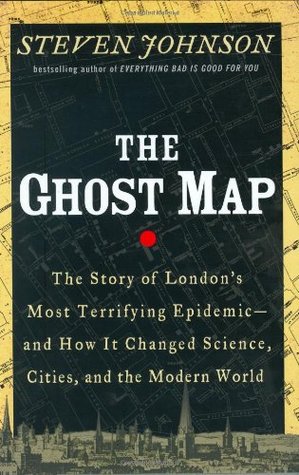 I love me some good nonfiction, and the story at the heart of The Ghost Map is one I'd encountered before but was interested in learning more about, so when it showed up at the library, I snatched it up.
I love me some good nonfiction, and the story at the heart of The Ghost Map is one I'd encountered before but was interested in learning more about, so when it showed up at the library, I snatched it up.The Ghost Map is the story of an outbreak of cholera in London in 1854 that ripped through a neighborhood like wildfire, far faster than any other cholera epidemic and with no visible source. While most of the city fretted about the poisonous "miasma" that they thought caused disease and every inhabitant who was still mobile fled the area, two men--Dr. John Snow and the clergyman Henry Whitehead--ultimately narrowed down the source of the outbreak to the Broad Street water pump (Snow) and the "patient zero" whose illness had contaminated the water therein (Whitehead). In doing so, they actually challenged the prevailing "germ theory" of the day, even though "germ theory" as it is today didn't exist then. Though their efforts didn't immediately revolutionize the world of public health, the case was still an important one in changing urban design, public health, and the future of cities in general.
This is a pretty short book. Most of it covers the "solving" of the cholera outbreak, along with the counterproductive efforts that were being undertaken by the "miasma" believers who thought that the disease must have been spread by London's poor air quality. But Johnson also dips into how cities were on the verge of collapse due to things such as epidemics and eventually into how this case of cholera set up a chain of events that ended with the revolutionizing of London's sewer system, water quality control, and overall approach to public health. In the wrap-up, Johnson moves to the big "but what does this mean to me?" question, in how the cities of today are still expanding. He goes into how cities are actually greener to live in than the countryside is due to economies to scale, how bioengineering can be used to essentially take out a bacterium or virus before it can even get started, how eighty percent of the world will probably eventually live in urban areas, how waste and clean water are interconnected.
The narrative parts of this book are excellent--you know, the parts that are really "solving the mystery." Snow went through a process that no one else had, not only mapping the deaths of the cholera victims geographically but also figuring out their connections to the Broad Street pump in order to determine that it was the source of the outbreak. Whitehead used his local knowledge and "ins" with the people of Soho in order to find the "patient zero" that caused the contamination in the first place. What was less fascinating was how Johnson kept hammering on the "BUT EVERYONE THOUGHT IT WAS MIASMA!!!!" angle. That was pretty apparent very quickly, but Johnson kept coming back to it, again and again and again, and just hammering on it. Additionally, while I think he raised some good points in the epilogue, it came across as scattered and unfocused, jumping from one type of threat to another--viruses, terrorists, nuclear holocausts... And by the time that he got there, I think he'd made his point thoroughly enough that I was ready to just be done with the book.
Overall, this is a book about a fascinating case that I'm not sure really does it justice. The thing is, there's not that much to be said about the case; I'm pretty sure there's an episode of a show on maps on Netflix that covers all of this pretty thoroughly in about half an hour. There's just so much added stuff in here that wasn't particularly intriguing or relevant that seemed to be added simply to bulk out the book and I think that did drag it down somewhat.
3 stars out of 5.
No comments:
Post a Comment